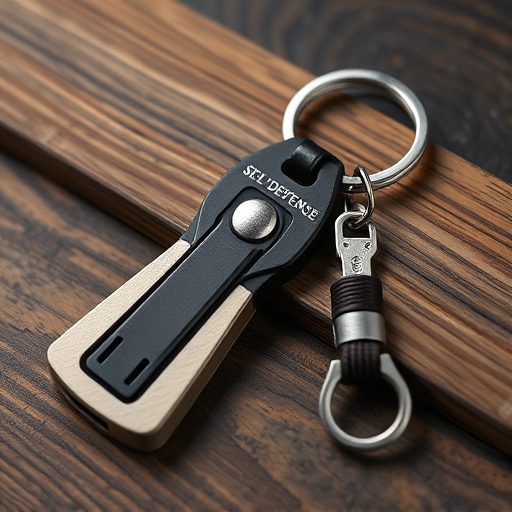The legality of keychain self-defense spike tools varies greatly across U.S. states, requiring users to understand local regulations. These compact devices are categorized as "self-defense" or "less-lethal," but specific definitions and restrictions differ. It's crucial to know your state's rules regarding size, capacity, purpose, age limits, registration, and permits before carrying such a tool for personal safety. Use should be a last resort, with intent clearly shown to avoid charges of excessive force. Regular testing and awareness are essential when carrying a keychain self-defense spike tool.
“In today’s uncertain times, personal safety is paramount. This article explores the legal landscape surrounding keychain self-defense spike tools, providing a comprehensive guide for those seeking protection. We delve into state-by-state laws, clarifying what’s permitted and what isn’t. Understanding these regulations is crucial when considering a keychain self-defense spike tool as a means of defense.
From legal definitions to safety practices, this overview ensures you’re informed about your rights and responsibilities.”
- Understanding Legal Definitions: Keychain Self Defense Spike Tools
- State-by-State Laws and Regulations: A Comprehensive Overview
- Permitted Use and Defense Against Charges
- Safety Considerations and Best Practices for Carrying a Keychain Self Defense Tool
Understanding Legal Definitions: Keychain Self Defense Spike Tools
When it comes to understanding the legal implications of carrying a keychain self-defense spike tool, it’s crucial to grasp the specific definitions and regulations set forth by individual states. These tools, designed for personal safety, are often compact and easily attachable to keys or bags, making them convenient defensive options. However, their legality varies widely across different jurisdictions.
In many states, keychain self-defense spike tools fall under specific categories of allowed defense mechanisms. The terminology used may include “self-defense devices,” “personal protection tools,” or “less-lethal weapons.” Each state has its own criteria defining what constitutes a legal self-defense tool, including requirements for size, capacity, and purpose. Some states explicitly prohibit certain types of spike tools due to their potential for causing excessive harm. Therefore, understanding the precise legal definition and specific regulations in your state is essential before considering carrying a keychain self-defense spike tool as a personal safety measure.
State-by-State Laws and Regulations: A Comprehensive Overview
In the United States, laws pertaining to keychain self-defense tools, such as the keychain self-defense spike, vary significantly from state to state. These small, easily concealable devices are designed to deter potential attackers and provide a means of escape in emergency situations. However, their legality is contingent upon local legislation. Some states explicitly allow the carriage of such tools for personal protection, while others have stringent restrictions or outright prohibit them.
Navigating these regulations requires thorough understanding, as they often involve specific requirements like age limits, registration, and permit systems. For instance, certain states may mandate that users possess a valid reason to carry a self-defense tool, while others might classify them as weapons, subjecting them to more rigorous control measures. Staying informed about the latest legal developments is crucial for those considering carrying a keychain self-defense spike tool to ensure compliance with state laws and regulations.
Permitted Use and Defense Against Charges
The permitted use of a keychain self-defense spike tool varies across states, but generally, it is designed for personal safety and protection against potential assailants. In many jurisdictions, carrying such a device is legal as long as it’s used responsibly and only for self-defense purposes. The tool should be seen as a last resort when facing an imminent threat, and users must understand the legal boundaries to avoid charges of excessive force or unlawful possession.
When defending against potential charges, individuals with keychain self-defense spike tools should prioritize demonstrating their intent to protect themselves rather than inflict harm. The key is to prove that the tool was used proportionately to the perceived danger, adhering to the legal standards set by each state. Understanding local laws and seeking clarification from law enforcement can help ensure that carrying and using a keychain self-defense spike tool remains a viable option for personal safety without inviting legal repercussions.
Safety Considerations and Best Practices for Carrying a Keychain Self Defense Tool
Carrying a keychain self-defense tool, like a spike or pepper spray, comes with both advantages and responsibilities. Safety should always be the top consideration when it comes to personal defense devices. It’s crucial to familiarize yourself with not only how to use the tool effectively but also local laws regarding its carry. In many states, these compact self-defense tools are legal as long as they don’t resemble a weapon of mass destruction and can be easily concealed on your keyring.
Best practices for carrying a keychain self-defense spike or pepper spray include keeping it readily accessible yet discreet. Ensure the device is easy to unlock with one hand in case of an emergency, but remember that practice makes perfect. Regularly test the tool’s functionality to ensure it will deploy as intended when needed. Additionally, be mindful of your surroundings and use the device only as a last resort, especially in public spaces where bystanders could be affected.
In conclusion, while keychain self-defense spike tools can be a convenient means of personal protection, understanding the legal landscape is paramount. Each state has specific regulations regarding their use and carrying, with varying levels of restriction and permitted defenses. Always check local laws to ensure compliance, prioritize safety, and avoid potential charges. Remember, being prepared for emergencies is crucial, but so is respecting the boundaries set by legislation.
